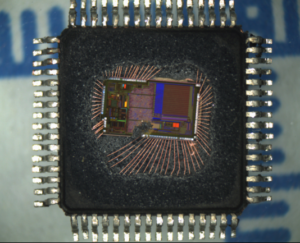Extract Secured MCU PIC16LF88 Flash memory program after attack microcontroller pic16f88 fuse bit,

The EUSART module has the capability of sending the special Break character sequences that are required by the LIN bus standard. A Break character consists of a Start bit, followed by 12 ‘0’ bits and a Stop bit when extract secured mcu flash.
To send a Break character, set the SENDB and TXEN bits of the TXSTA register. The Break character transmission is then initiated by a write to the TXREG. The value of data written to TXREG will be ignored and all ‘0’s will be transmitted.
The SENDB bit is automatically reset by hardware after the corresponding Stop bit is sent. This allows the user to preload the transmit FIFO with the next transmit byte following the Break character (typically, the Sync character in the LIN specification).
The TRMT bit of the TXSTA register indicates when the transmit operation is active or Idle, just as it does during normal transmission. See Figure 12-9 for the timing of the Break character sequence. The following sequence will start a message frame header made up of a Break, followed by an auto-baud Sync byte. This sequence is typical of a LIN bus master when extract secured mcu flash.
Configure the EUSART for the desired mode. Set the TXEN and SENDB bits to enable the Break sequence. Load the TXREG with a dummy character to initiate transmission (the value is ignored) if extract secured mcu flash.
Write ‘55h’ to TXREG to load the Sync character into the transmit FIFO buffer. After the Break has been sent, the SENDB bit is reset by hardware and the Sync character is then transmitted. When the TXREG becomes empty, as indicated by the TXIF, the next data byte can be written to TXREG.
The Enhanced EUSART module can receive a Break character in two ways. The first method to detect a Break character uses the FERR bit of the RCSTA register and the Received data as indicated by RCREG to crack MCU. The Baud Rate Generator is assumed to have been initialized to the expected baud rate.

